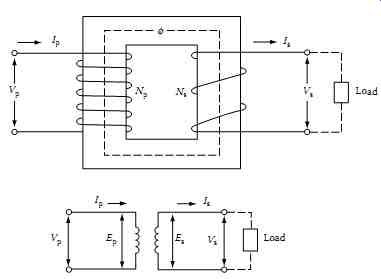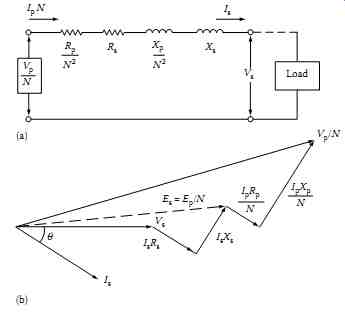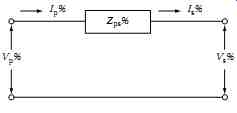AMAZON multi-meters discounts AMAZON oscilloscope discounts
1. Introduction
This section covers information on the maintenance and testing of power transformers. To ensure trouble-free service over the life of the transformer, it has to be maintained regularly, but equally important it must be operated properly. Therefore this section provides information on the basic design, construction, application, and operation of power distribution transformers with the expectation that this information will help toward better care and maintenance of transformers.
A transformer is an energy transformation device that transforms alternating current (AC) or voltage at one level to AC and voltage at another level. A transformer can economically convert voltage or current from low to high levels, or from high to low levels. The transformer usually consists of two or more insulated windings on a common iron core. In industrial and commercial applications, transformers are used to step down voltages from utility service voltage to lower distribution voltage levels or lower utilization voltages that may be required for a facility or a plant. Transformers are very reliable devices and can provide service for a long time if maintained and serviced regularly. Transformer failures, when they occur, are usually of a very serious nature, which may require costly repairs and long downtime. The best insurance against transformer failure is to ensure that they are properly installed and maintained.
2. Transformer Categories and Type
For consideration of maintenance requirements, transformers can be divided into the following categories:
- Insulating medium
- Construction
- Application and use
2.1 Insulating Medium
The transformer's insulating medium can be subdivided into two types: dry and liquid filled.
2.1.1 Dry Type
Dry-type transformers are usually air cooled with winding insulation of class A, B, C, or H. The dry-type transformer can be either self-cooled or forced air cooled.
Self-cooled: A self-cooled transformer of the dry type is cooled by natural circulation of air through the transformer case. The cooling class designation for this transformer is AA.
Forced air cooled: A forced air-cooled transformer of dry type is cooled by means of forced circulation of air through the case. Transformers of this type have air-blast equipment such as fans with louvered or screened openings.
These transformers are rated at 133% of the rating of the self-cooled dry-type transformers. The cooling class designation for this transformer is FA. Dry type transformers can be obtained with both self-cooled and forced air-cooled rating. The designation for such a transformer is AA/FA. Dry-type transformers can also be cooled by gas instead of air. For such transformers, a sealed tank is required.
2.1.2 Liquid-Filled Transformer
In this type of transformer, the windings and core are totally immersed in a liquid contained in the transformer tank. The tank is equipped with cooling fins for circulation of the transformer liquid. The transformer liquid provides an insulating medium for the coils as well as for dissipation of heat. Two liquids have been used extensively in the past for transformers: mineral oils and polychlorinated biphenyls (PCB), commonly known as askarel. Askarel was extensively used in transformers for indoor applications because it is a nonflammable synthetic insulating fluid. Askarel is a non-biodegradable and toxic. Environmental Protection Agency (EPA) banned the use of askarel in transformers and other electrical equipment, and its availability for reuse or for use in new applications is almost nonexistent. Newer fluids have been introduced, such as silicone, RTemp, Wecosal, and Alpha 1 for replacement of askarel. Others are still in developmental stages. Regardless of what new fluids come on the market for transformer applications, they would still have to be maintained and tested to assure transformer integrity.
Several cooling methods are used for liquid-filled transformers.
Self-cooled: A self-cooled transformer uses the natural circulation of the insulating liquid. Heat in the transformer tank is dissipated by convection currents set up in the liquid, which circulates through the tank and cooling fins. The cooling class designation for this transformer is oil natural, air natural OA.
Forced air cooled: In this type of transformer, air is forced over the cooling surface of the tank to supplement the self-cooled rating. The supplemental air is manually or automatically controlled. The cooling class designation for this type of transformer is OA/FA.
Forced air cooled and forced oil cooled: This transformer uses a pump to circulate oil through a heat exchanger to increase heat dissipation, which supplements the self-cooling and forced air cooling. The cooling class designation for this transformer is OA/FA/FOA.
Water cooled: This transformer uses water instead of air to provide the cooling. The cooling system consists of a heat exchange by means of water pumped through a pipe coil installed inside or outside the transformer tank.
The cooling class designation for this transformer is FOW.
2.2 Construction
Transformers can be classified by tank construction and core construction.
2.2.1 Tank Construction
Several types of transformer tank construction are used to prevent exposing liquid to the atmosphere. These types are as follows:
Free breathing: This type is open to the atmosphere (i.e., the airspace above the liquid is at atmospheric pressure). The transformer breathes as the air pres sure and temperature change outside the tank. Some of these transformers can be equipped with dehydrating compounds in the breather.
Conservator or expansion-tank: These transformers are equipped with small expansion tanks above the transformer tank. The transformer tank is completely filled with oil, and the transformer breathes by means of this small tank, usually through a dehydrating compound. The purpose of the small tank is to seal the transformer fluid from the atmosphere and to reduce oxidization and formation of sludge.
Sealed tank: These transformers are equipped with an inert gas, such as nitrogen that is under pressure above the liquid in the transformer tank.
Generally, the pressure range for this type of transformer is -8 to +8 lb/in.^2 Gas-oil sealed: These transformers have an auxiliary tank to completely seal the interior tank, containing transformer liquid, from the atmosphere.
Vaporization: This type of transformer uses a special nonflammable insulating fluid, such as fluorocarbon (General Electric R-113), which is nonflammable, and a special condenser assembly welded on top of the transformer tank. The cooling tube ends are swaged and welded to tube headers. This transformer uses the technique of sprayed liquid on core and coil assembly (i.e., vaporization cooling known as pool boiling). The purpose of the con denser is to cool the boiling vapor into liquid for continued circulation of the fluid.

FIG. 1 Three-phase core construction.
2.2.2 Core Construction
Transformers employ basically two types of core construction techniques.
Core type: In core-type construction, the transformer winding surrounds the laminated core. The coils can be cylindrical, l at, or disk shaped. They can be arranged to i t around the rectangle or square cross section of the core, as shown in FIG. 1. Core-type construction provides a single-path magnetic circuit through the magnetic core. Most small distribution transformers are of this construction.
Shell type: In shell-type construction, the magnetic core surrounds the windings, as shown in FIG. 2. The primary and secondary windings may be interspaced side by side or circularly stacked one above the other. Some large power transformers have this form of construction. One advantage of the shell type is that it offers a separate path for the zero-sequence currents through the core, as compared to the core type in which the zero-sequence path exists only through the transformer tank and end connections.
3. Application and Use
Transformers used for converting energy can be classified into five categories according to their application and use.
3.1 Distribution Transformers
A distribution transformer has a rating from 3 to 500 kVA. There are various types of distribution transformers, depending upon the cooling and insulating medium, service application, and mounting method. Transformers with voltage ratings of as high as 34,500 V are available. Virtually all distribution transformers are self-cooled.
3.2 Network Transformer
This is considered a distribution transformer per National Electrical Manufacturers Association (NEMA) standards and has characteristics similar to the distribution transformer. However, its application is different. It has special and severe requirements for network service, such as ventilation, vault size, submersibility, and short-circuit requirements. Network transformers can have kVA ratings in excess of 500 kVA and primary voltage up to 23 kV.

FIG. 2 Three-phase and three single-phase shell type of construction.
3.3 Arc-Furnace Transformer
The arc-furnace transformer is a special purpose transformer used in process industries. It is a low-voltage and high-amperage transformer and is specially braced to withstand mechanical stresses caused by fluctuating current requirements. Due to distorted waveform because of arcs, it has extra winding insulation.
3.4 Rectifier Transformer
The rectifier transformer is also a special purpose transformer used in the rectification of AC to direct current (DC) applications in the process industry.
These transformers are specially braced to withstand mechanical stresses produced by high currents.
3.5 Power Transformer
The power transformer has a rating in excess of 500 kVA and is primarily used in transforming energy from generating stations to transmission lines, from transmission lines to distribution substations, or from utility service lines to plant distribution substations.
4. Transformer Fundamentals
The transformer was invented in 1886 by William Stanley and is a very useful device. A transformer can be divided into three parts: primary winding, secondary winding, and core. The primary and secondary windings are linked by common flux produced in the iron core, as shown in FIG. 3.
The following symbols are used for transformer voltages, currents, and impedances.

FIG. 3 Connection and circuit diagram of a simple transformer.
Primary side:
Vp is the primary voltage
Np is the primary turns
Zps is the leakage impedance (O)
Ip is the primary current
Secondary side:
Vs is the secondary voltage Ns is the secondary turns Zsp is the leakage impedance (Ohm) I_s is the secondary current Let us assume that the primary winding is energized by connecting it to an AC supply voltage, Vp. This sets up the primary current, which produces an alternating magnetic field in the iron core that is continually building up and collapsing in both positive and negative directions. The instantaneous induced voltage in the primary winding can be expressed by Faraday's law as
- F =- 8 pp d 10 V d eN t
where F = Fmax = sin wt and Fmax = maximum instantaneous flux in the core.
The rms value of this voltage can be expressed as
8 pmax p 4.44 10 V efNAB -
where f is the frequency Np is the number of turns in primary winding A is the area of the core Bmax is the maximum flux density The alternating flux produced by the primary winding in the core links the secondary winding and thus induces an alternating voltage in the secondary winding, which can also be expressed as
8 ss max 4.44 10 V efNAB -
= where es is secondary voltage Assuming that the secondary winding is open (no-load condition, Is = 0) and the transformer is energized from the primary side, a small current, In, will flow in the primary winding. This current is called exciting current and sets up the alternating flux consisting of the following:
• Mutual flux whose path is through the core
• Leakage flux whose path is through the air
In commercial power transformers, the leakage flux is very small and is often neglected. The alternating flux in the iron core induces voltage in the primary and secondary windings. The induced voltage in the secondary produces a back electromotive force (emf) due to self-inductance.
According to Lenz's law, the back emf is equal to applied voltage to the primary winding under no-load conditions. The applied voltage can be expressed as follows:
Applied voltage = total induced voltage - resistance drop in the primary winding
Neglecting the resistance drop in the primary winding, we can write Applied voltage = induced voltage
= pp Ve
When load is applied to the secondary winding, a proportional primary cur rent will flow corresponding to the secondary current. As the load is applied to the transformer, the voltage transformation ratio will deviate from the true transformer winding turns ratio. These small errors can generally be neglected in power transformers. In addition to the voltage drop in primary and
secondary windings, losses due to the exciting current and load current have to be considered. Transformer losses can be divided in two types:
Copper loss (I^2R): This is power loss in the resistance of the primary and secondary winding due to load and magnetizing current of transformer.
Core loss: This is power loss in the transformer core and is due to the exciting current. The core loss can be subdivided into eddy current and hysteresis losses. Eddy current losses are due to eddy and small circulating currents in the core, whereas hysteresis losses are caused by the energy required to align the domains in the magnetic core material. Core loss is continuous as long as the transformer is energized.
A two-winding power transformer can be represented by an equivalent circuit diagram as shown in FIG. 4. The exciting current of the transformer, represented by In, is shown as flowing to the magnetizing branch of shunt conductance and susceptance. The exciting current for power transformers usually ranges from 3% to 6%. To simplify the equivalent circuit, the exciting current may be neglected. Furthermore, the equivalent circuit diagram can be based upon the primary or secondary voltage. FIG. 5a shows the equivalent circuit diagram of a transformer based on the secondary side.
Sometimes it is desirable to represent a transformer by vector diagrams (the relationship of the primary and secondary currents and voltages). The vector diagram shown in the FIG. 5b is based upon the equivalent circuit diagram shown in FIG. 5a.

FIG. 4 Transformer equivalent diagram.

FIG. 5 (a) Simplified equivalent diagram of transformer and (b) simplified
vector diagram of transformer.
It is important to know the relationship between transformer voltage and current as energy is transformed from one voltage level to another. Consider the transformer shown in FIG. 6. The voltage, current, and impedance are expressed as follows:
4.1 Voltage Relationship
According to Faraday's law,

FIG. 6 Graphical representation of a power transformer.
4.2 Current Relationship Power in = power out (ideal transformer)
4.3 Impedance Relationship
Zps is defined as the leakage impedance between primary and secondary winding measured in ohms on the primary winding with the secondary winding short circuited. The value of Z is given by the following:
Zsp is defined as the leakage impedance between secondary and primary winding measured in ohms on the secondary winding with the primary winding short circuited. The value of Zsp is given by the following:
4.4 Summary
The voltage, current, and impedance equations for the transformer can be rewritten as follows:
Generally, for power transformers the impedance is specified in a percentage rather than actual ohms. The percentage of impedance of a transformer can be expressed as
The percentage of impedance can be expressed independently of the terminal voltages and is based on the kVA rating of the transformer. The equivalent circuit diagram of a transformer on a percentage basis is shown in FIG. 7.

FIG. 7 Percentage equivalent circuit of transformer.